Teeth Selection Brief Introduction
Teeth selection is important procedure which requires knowledge of denture foundation and patient’s demand of esthetic. Various factors affect the selection of teeth like, available bone support, type of mucosa, the relationship of edentulous jaws with each other and patient demand. This chapter briefly explains about various available methods used to select artificial teeth.
Table of Contents
Teeth Selection Brief Definition
The selection of a tooth or teeth of a shape, size, and color to harmonize with the individual characteristics of a patient.
Read and Learn More: Preclinical Prosthodontics Notes
Objectives Of Teeth Selection
- The anterior teeth selected should be esthetically acceptable and should perform their function.
- Posterior teeth selected should aid in denture stability and should be efficient in mastication.
- They should not abuse the tissue over residual ridges.
- They should maintain correct vertical dimension.
- They should not impair the speech.
Anterior Teeth Selection
Esthetic is the prime objective in selection of artificial anterior teeth. Before selection of teeth one should inform the patient and should approve it from patient. During anterior teeth selection various parameters are taken into considerations.
They are as follow:
- Size of the teeth
- Shape of the teeth
- Color/shade of the teeth
- Material of teeth (acrylic, porcelain, etc.).
Selection of Teeth Size:
Various factors are considered during selection of proper teeth size.
Three main factors are:
- Width—mesiodistal width
- Length—incisogingival length
- Thickness—labiolingual thickness
There are various subjective and objective methods available for selection of teeth size.
Selection of Teeth Shape:
Shape of artificial teeth can be selected using preextracted and postextracted records of the patient. Commonly used method is based on classification proposed by Leon and Williams. According to them the shape of teeth should be inverse of the shape of face.
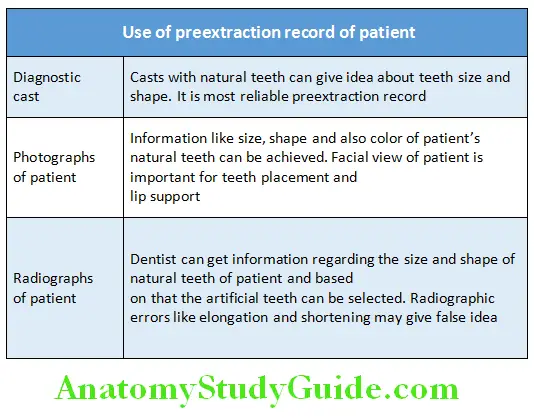

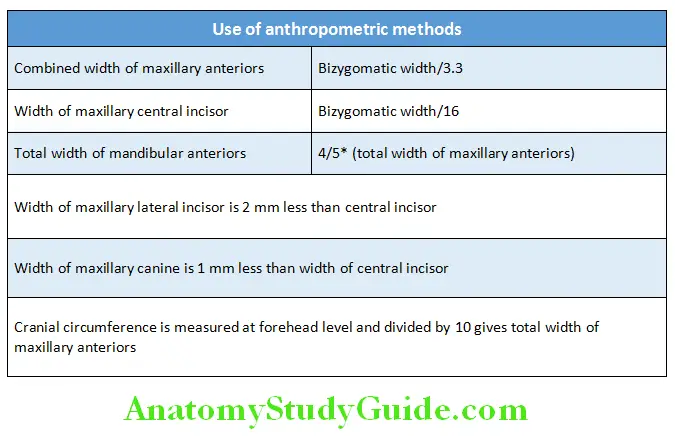
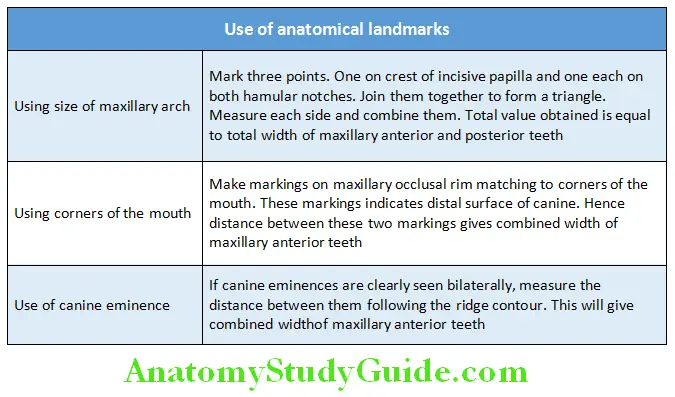
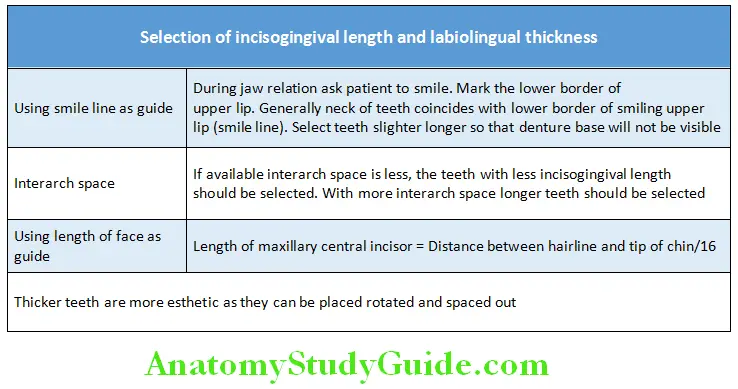
The shape of the maxillary central incisor should resemble the facial form (shape of face) if it was placed upside down. The teeth selection based on facial form is also known as geometric theory. The facial form is identified by connecting the following points on the face.
- The forehead
- Zygomatic arch
- Angle of mandible.
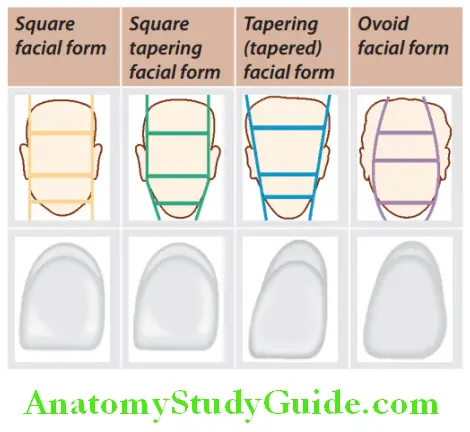
According to this the facial form can be classified as given in Table.
Selection of Teeth Color/Shade:
In selection of tooth shade, components of color, i.e. hue, value, and croma play a major role. Apart from these opacity, translucency, transparency, metamerism, and fluorescence are also important factors.

Posterior Teeth Selection
Selection of Size of Posterior Teeth:
Note: If teeth are placed beyond maxillary tuberosity, it results in tipping of denture and cheek biting. If teeth are placed on retromolar pad (as it is displaceable tissue) results in tipping of denture during mastication.
Selection of Shape of Posterior Teeth:
Posterior teeth are available in various shapes. Their selection for edentulous patient depends on ridge condition, jaw discrepancies, and systemic conditions (poor neuromuscular control, Parkinsonism).
- Anatomical teeth—when ridges are well formed.
- Semi-anatomic teeth—used when ridges are fair.
- Nonanatomic teeth—used when ridges are poor.
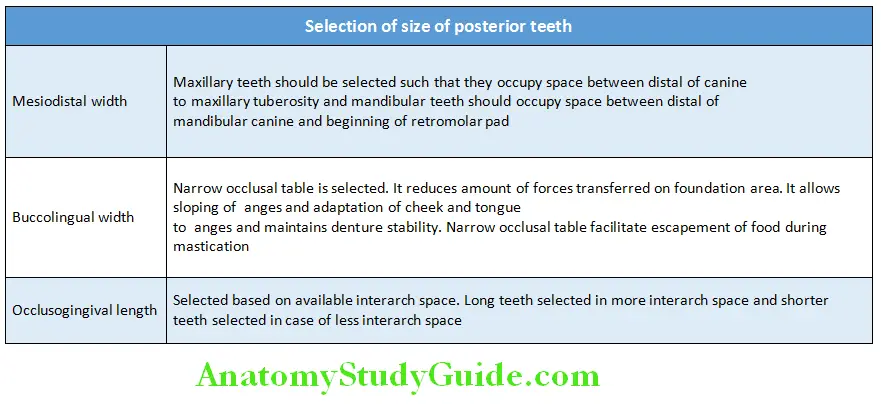


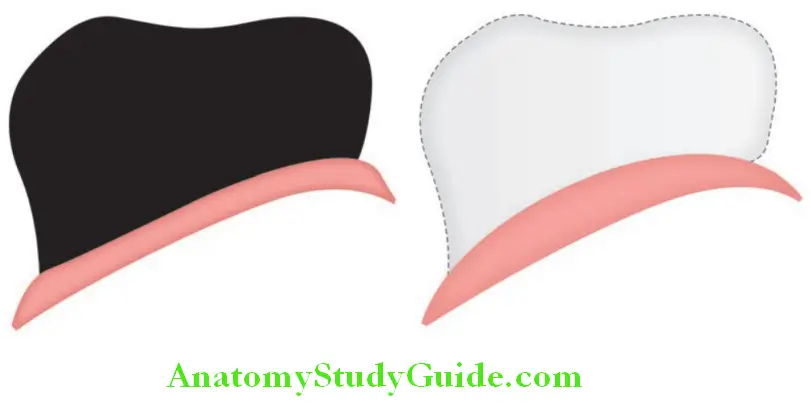
Dentogenic Concept (S.P.A Guidelines)
This concept was proposed by Frush and Fisher. They suggested guidelines for selection and arrangement of teeth based on three factors, i.e.
- Sex
- Personality
- Age.
Sex:
The characteristic difference in teeth of male and female is listed in Table.
Personality:
Flush and Fisher used personality spectrum consisting in see Table.
Age:
According to dentogenic concept the visibility of maxillary and mandibular teeth varies according to age of the patient. In young age patient, there is considerable exposure of maxillary central incisors but in old aged patient there is no exposure.
The opposite occurs for mandibular teeth, less exposure of mandibular teeth for young patient and more exposure of mandibular incisors for old aged patients.
Natural teeth wear with increasing age in most of the patients; this can be duplicated in denture by grinding the incisal edges of anterior teeth. Gingival papillae in old age become blunted and shortened; this should be duplicated in denture wax up.

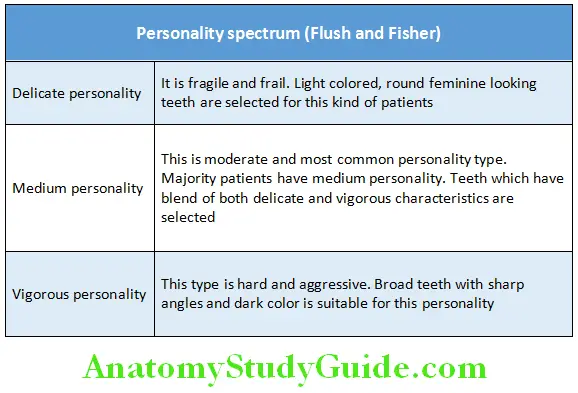
Leave a Reply